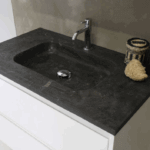How To Remove a Bathtub Faucet

Taking off a bathtub faucet may appear overwhelming, but with the correct tools and simple directions, it’s a doable D.I.Y. project that will save you the expense of hiring a plumber. Whether you’re refreshing the look in your bathroom, repairing an ongoing leak, or putting in a new model, this how-to from our team at Allied Plumbing & Heating Supply Co. covers what you need to do for a complete flush.
Understanding Your Bathtub Faucet Type
Determining the type of faucet in the bathtub is vital before learning how to change it. There are two styles: slip-on, which fastens using a set screw, and screw-on, which threads directly onto plumbing. The type will determine how to remove it and what tools you need to perform the job. Before you begin, it is essential to identify whether your faucet is a slip-on or screw-on type faucet.
- Slip-on faucets have a set screw located just below the spout in the wall that holds them in place. Unlike other types, these faucets have smooth “neck” designs and can be removed easily without tools.
- Screw-on faucets thread directly onto the plumbing, making for a more secure fit in most cases. Removing them typically requires a wrench or pliers.
Tools and Materials Checklist
Before diving in, you need to ensure you have the right tools and materials ready to ensure a smooth and successful project.
- Slip-on faucets. Use a flathead screwdriver or a hex key to loosen the set screw. These tools are great for turning nuts or bolts on small parts without nicking the faucet’s finish.
- Screw-on faucets. You also need a pipe wrench or adjustable pliers to turn tight faucets and a plumber’s tape to reseal the connection after installing the new faucet.
Whether you have a faucet with a separate sprayer or one without, it’s a good idea to have some soft towels or thick cloths available. Use these to cover the surfaces around your work area, simply the bathtub, to avoid scrapes or other damage.
Preparation Steps Before Removal
Before removing your bathtub faucet, you need to ensure your home’s main water valve is off. It’s your first line of defense to prevent surprises or water messes from occurring and causing unnecessary headaches. Shut off the water, then open the faucet to drain water in the pipes. This will clear up the whole system and prevent water from spilling everywhere as much as possible, making the faucet removal slightly cleaner and more manageable. Those precautions help keep your workspace dry and your project on track.
Removing a Slip-On Faucet
Here’s how to remove a slip-on faucet:
- Identify the set screw. The first step is to identify the set screw underneath the faucet spout. It might be hidden behind a decorative cap. If a set screw is covered, gently pry up the cap with a flathead screwdriver.
- Loosen the set screw. Once the set screw is exposed, insert a hex key into it and turn counterclockwise. Continue to turn until the set screw is loose enough for the faucet to slip easily off its mounting.
- Detach the faucet. Pull the faucet out from the wall carefully. If it resists, you can wiggle it a little to shake loose any debris or corrosion that might be holding it in place. Don’t force yourself, as this can damage the plumbing.
Removing a Screw-On Faucet
Here are the steps for unscrewing a faucet:
- Use penetrating oil. If the faucet looks older or rust-covered, spray some penetrating oil where the connection is. This will help loosen the faucet by eating away at rust and buildup to make it easier to unscrew.
- Loosen the faucet. Grab the faucet with a pipe wrench or pliers and twist it counterclockwise. Use consistent force along the way to maintain smooth and even motion so you do not damage the plumbing.
- Clean the threads. Once you have removed the faucet, wipe off any old plumber’s tape or residue from the plumbing threads. This measure is essential in establishing a clean surface for the proper establishment of the new faucet, festering avoidances of leaks, something that could lead to a lot of ugly consequences in the long run.
Troubleshooting Common Issues
When faced with a faucet that simply will not budge, it typically responds to corrosion or a stripped set screw. For rusty bolts, this means soaking the area with plenty of penetrating oil. Let the oil sit for several minutes or longer if the corrosion is particularly bad. This will help get rid of the rust and help the faucet release.
With a ruined set screw, things are touchy but need to be steadfast. These work by drilling out the screw head as you normally would, only you don’t want to go all the way and drill through the threaded part, so choose a drill size that is somewhat smaller than the set screw itself. Gently drill through the center of the set screw to create a new groove or to weaken its hold. Proceed with caution in this step so that you do not drill too deep and hit the plumbing beneath. When the set screw is loose enough, you use an ordinary screwdriver to screw it out some.
Shop Bathtubs and Faucets at Allied Plumbing & Heating Supply Co.
At Allied Plumbing & Heating Supply Co. in Chicago, we offer a wide selection of bathtubs and bathroom fixtures. Call our expert team at 773-777-2670 or complete our secure online form to get started. With a wide selection of high-quality products, expert guidance, and reliable service, we’re here to help you bring your dream space to life. Let us be your trusted partner in transforming your bathroom into the perfect haven.
bathtub faucet by Jo Naylor is licensed with CC BY 2.0 DEED


